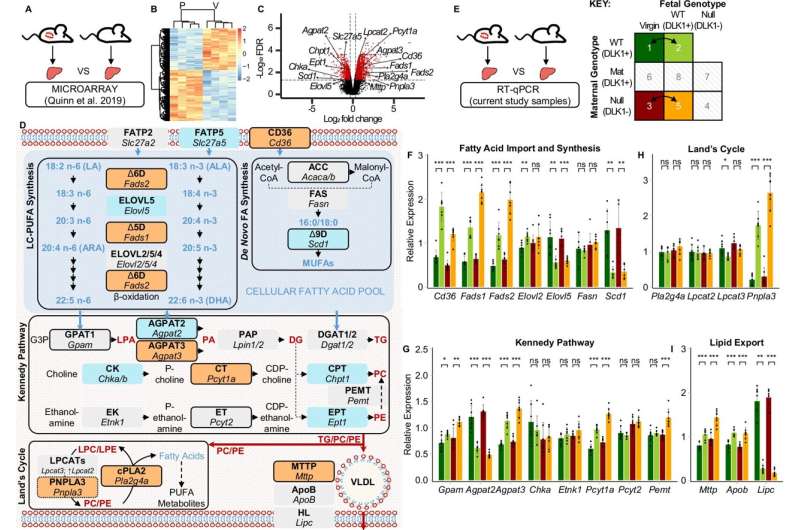This article has been reviewed according to Science X's editorial process and policies. Editors have highlighted the following attributes while ensuring the content's credibility:
fact-checked
peer-reviewed publication
trusted source
proofread
Researchers identify molecular mechanism that transports important dietary fats to the fetus

Research in mouse models has identified a new mechanism for how long-chain polyunsaturated fatty acids (LC-PUFAs), like omega-3s, are transported from the mother to the fetus during pregnancy. The results, published in Nature Communications, could help to identify ways to tackle LC-PUFA deficiency in the developing fetus.
LC-PUFAs are a group of fatty acids that are essential to the functioning of the body. They are used in cell walls, provide an essential layer of insulation (known as myelin) around nerve cells, and are involved in a range of processes in human cells. There are two groups of LC-PUFAs—omega-3s and omega-6s.
As humans, we can't create our own LC-PUFAs, and so we must acquire them through our diets. LC-PUFA deficiency during pregnancy can lead to a number of complications, including stillbirth, fetal growth problems and an increased chance of neurodevelopmental problems in the child.
Clinical trials aimed at reversing LC-PUFA deficiency by giving supplements to the mother have had limited success, partly due to a poor understanding of how the mother provides fatty acids to the fetus. The findings from this study have begun to plug this knowledge gap.
Led by Marika Charalambous, Professor in Developmental Physiology at King's, the team found that LC-PUFA stores in the mother are transported to the fetus in carrier molecules called lipoproteins. Using a technique called mass spectrometry, the team looked at the fatty acids present in the blood and livers of mice who were pregnant and mice who were not.
Pregnant mice had much higher levels of LC-PUFAs in their blood lipoproteins. When the placenta detects these lipoproteins, it pulls out the LC-PUFAs from them to deliver the essential fatty acids to the fetus.
The researchers also took advantage of a computational gene expression profiling technique that can identify how genes controlling this process are turned on and off. The "Liver X Receptor"—a protein that switches on the genes that control the metabolism of fats—was found to be activated during late pregnancy and linked to a significant increase in the supply of LC-PUFAs within pregnant mice. When the Liver X Receptor was deleted from the mothers' genetic code, the levels of LC-PUFAs were halved in the fetus.
"Our study has shed light on a new mechanism for how a mother mobilizes her fuel sources to feed the baby. We know very little about the biology of women, as in the past it was assumed that female biology was the same as male biology. Historically, women weren't included in medical studies, and animal models of metabolic biology were done using only male mice.
"By better understanding the biology of how a mother transports nutrients to the fetus, we'll be able to intervene in much cleverer ways to prevent LC-PUFA deficiency and adverse outcomes," says Charalambous.
The results are a first step in understanding the unique and complex mechanisms of metabolism during pregnancy. The team hopes the findings could be used to inform the design of new clinical interventions in the future to improve pregnancy outcomes for both the mother and child.
More information: Risha Amarsi et al, A co-ordinated transcriptional programme in the maternal liver supplies long chain polyunsaturated fatty acids to the conceptus using phospholipids, Nature Communications (2024). DOI: 10.1038/s41467-024-51089-z



















